Winter moth & Gypsy moth – Fall 2016
Winter Moth
Winter moth moths will be emerging from the soil from late November through December. Throughout Rhode Island you may see small gray moths attracted to porch lights in large numbers and clouds of moths in headlights, especially on warm evenings. These are all male moths – females have tiny wings and cannot fly. Females emerge from the ground and climb up nearby tree trunks where they mate and lay eggs. In early spring, newly hatched caterpillars crawl into swelling buds and begin feeding.
Trying to control male winter moths is useless and pesticide sprays aren’t known to be effective controlling female winter moths. Many people are interested in using tree wraps to capture female moths as they climb up trees. Tree banding will probably be most successful in yards with very few trees, no woods nearby, and a small to moderate-sized winter moth population.
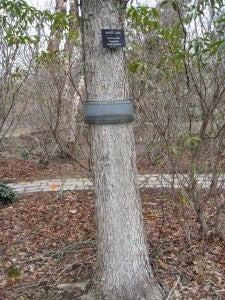
BugBarrierset up on tree trunk by mid-November.
Last year I set up two tree wraps on one tree trunk. The lower tree wrap caught 207 female winter moths and the tree wrap higher in the tree caught 138 female winter moths. So at least 138 female moths got past the first barrier and an unknown number of moths got past the second barrier. This year I’ll set up 3 or more bands on one tree trunk.
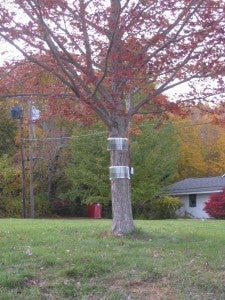
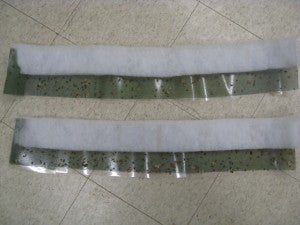
Double tree wrap of BugBarrier. Lower band 207 females, upper band 138 female winter moths, Jan. 2016
Tree bands should be in place by mid-November. Tree bands can be homemade or purchased from some garden centers. Commercial products include BugBarrier and Tree Wrap. BugBarrier can be purchased from Tree Shelter in Attleboro Falls, MA. Homemade bands can be made by spreading a sticky substance, such as Tree Tanglefoot, to duct tape or plastic wrap attached to tree trunks. Be sure there are no gaps between the wrap and tree trunk otherwise female moths will climb behind the wrap and bypass the trap. Don’t coat tree trunks directly with Tanglefoot or any sticky substance.
Click on link to see a video about setting up BugBarrier
Where there is a large population of winter moths, dead moths can completely cover the sticky surface and then female moths can easily walk over dead moths. Be sure to check traps frequently and remove moths if necessary.
When a female moth encounters a tree wrap she tends to lay many eggs right below the tree band. For this reason, tree trunks with must be sprayed with a dormant oil from the tree wrap down to the ground next March or April, before winter moth egg hatch, to kill eggs on the trunk.
Gypsy moth
Gypsy moth caterpillars defoliated thousands of acres in RI in 2016 and are poised to do it again in 2017. Right now, gypsy moths are present as eggmasses on tree trunks, branches and many structures. These eggmasses will hatch in early May and caterpillars will feed through June. Hopefully we will have normal spring weather (not droughty!) and most gypsy moth caterpillars will die of the two diseases that usually control gypsy moth populations. The problem is, the fungal and viral diseases do not start spreading until gypsy moth caterpillars are half-grown, and most diseased caterpillars don’t die until they are full-grown – after they have consumed a lot of foliage.
After leaf drop and before eggs hatch in early May, eggmasses can be scraped off or sprayed with 1-3% horticultural oil. (Oil should not be applied when temperatures are predicted to be below 40 degrees within the next 24 hours.) This seems like a difficult (or perhaps impossible) task given there are so many eggmasses and so many are high in trees. Still, many people are looking for something they can do to reduce gypsy moth numbers.
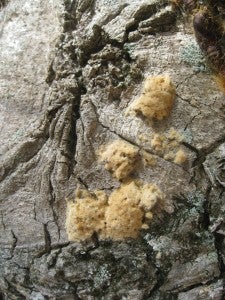
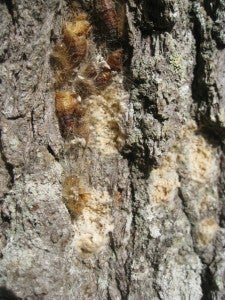
Gypsy moth eggmasses in October and empty pupal cases.
 Home
Home Browse
Browse Close
Close Events
Events Maps
Maps Email
Email Brightspace
Brightspace eCampus
eCampus


